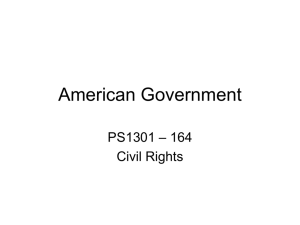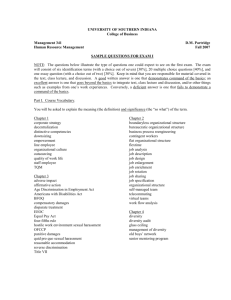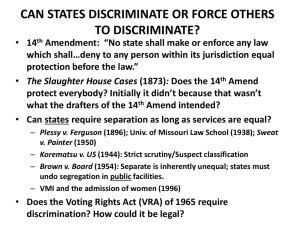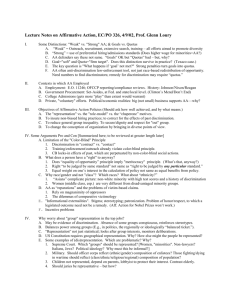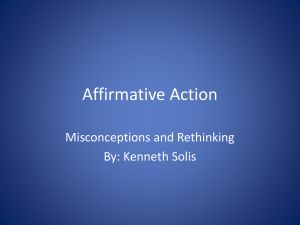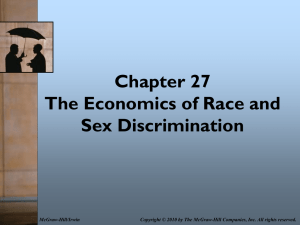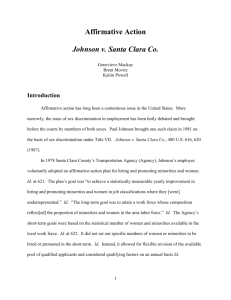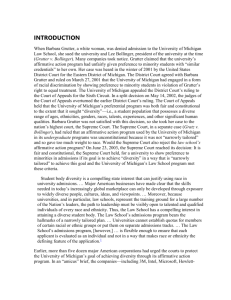Chapter 11 Notre Dame did not hire an African
advertisement
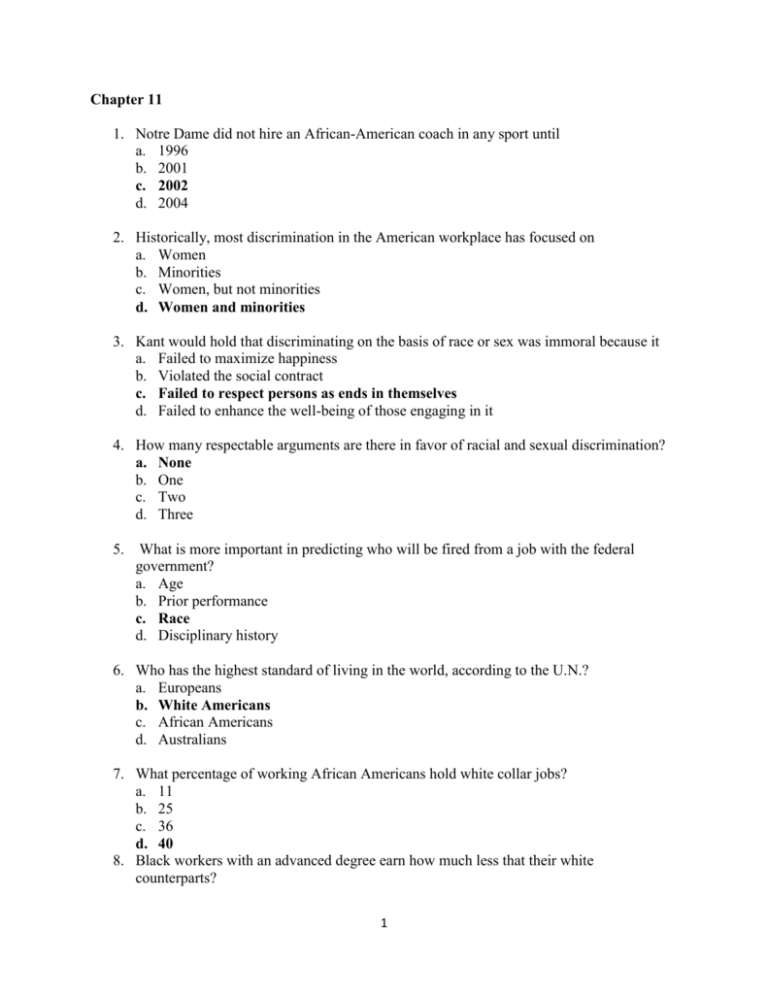
Chapter 11 1. Notre Dame did not hire an African-American coach in any sport until a. 1996 b. 2001 c. 2002 d. 2004 2. Historically, most discrimination in the American workplace has focused on a. Women b. Minorities c. Women, but not minorities d. Women and minorities 3. Kant would hold that discriminating on the basis of race or sex was immoral because it a. Failed to maximize happiness b. Violated the social contract c. Failed to respect persons as ends in themselves d. Failed to enhance the well-being of those engaging in it 4. How many respectable arguments are there in favor of racial and sexual discrimination? a. None b. One c. Two d. Three 5. What is more important in predicting who will be fired from a job with the federal government? a. Age b. Prior performance c. Race d. Disciplinary history 6. Who has the highest standard of living in the world, according to the U.N.? a. Europeans b. White Americans c. African Americans d. Australians 7. What percentage of working African Americans hold white collar jobs? a. 11 b. 25 c. 36 d. 40 8. Black workers with an advanced degree earn how much less that their white counterparts? 1 a. b. c. d. 10% 15% 25% 30% 9. Women are clustered in a. White collar occupations b. Blue collar occupations c. Yellow collar occupations d. Pink collar occupations 10. The first African American CEO of a Fortune 500 company was hired in a. 1979 b. 1989 c. 1999 d. 2009 11. In finance, how many cents do women make for every dollar earned by men? a. 45 b. 56 c. 68 d. 76 12. Which Title of the Civil Rights Act of 1964 prohibits sexual and racial discrimination at work? a. VI b. VII c. VIII d. IX 13. How many male minority executives in large companies report feeling constrained by the white male model? a. 24 b. 34 c. 44 d. 54 14. Edward W. Jones holds that all people a. Possess stereotypes b. Are biased against others of a different race c. Are biased against others of a different sex d. Are incompetent in different ways 15. According to Edward W. Jones, stereotypes are powerful because of their a. Accuracy b. Circularity 2 c. Psychological force d. Adaptive advantage 16. Which court case decided that racially segregated schooling was unconstitutional? a. Bakke v. Regents of the University of California b. Brown v. Board c. Griggs v. Palmer d. Griswold v. Connecticut 17. When was the Equal Pay Act passed? a. 1961 b. 1963 c. 1964 d. 1965 18. What started the change towards laws that attempt to safeguard the right of each person to equal treatment in employment? a. Executive Order 10925 b. The Equal Pay Act c. The Civil Rights Act d. Executive Order 10256 19. What programs are designed to correct imbalances in employment that exist directly as a result of past discriminations? a. Social Workshop Programs b. Negative Action Programs c. Race-based Priority Programs d. Affirmative Action Programs 20. What proportion of persons entering the workforce today are minorities or immigrants? a. 25% b. 50% c. 65% d. 80% 21. The U.S. Supreme Court’s first major ruling on affirmative action was in a. Brown v. Board b. Griggs v. Palmer c. Griswold v. Connecticut d. Bakke v. Regents of the University of California 22. In Memphis Firefights v. Stotts the Supreme Court upheld a. Seniority over affirmative action b. Nepotism over affirmative action c. Affirmative action over seniority d. Affirmative action over nepotism 3 23. In her majority opinion in Grutter v. Bollinger Justice O’Connor wrote that raceconscious admissions policies must be a. Continued indefinitely b. Limited in time c. Prohibited shortly d. Imposed in all schools 24. Critics of affirmative action often label it a. Positive discrimination b. Reverse discrimination c. Unconstitutional discrimination d. Paternalistic discrimination T 1. The doctrine of comparable worth holds that women and men should be paid on the same scale not only for doing the same or equivalent jobs but for doing jobs that involve equal skill, effort, and responsibility. F 2. Legal secretaries, who are mainly women, earn more than instrument repair technicians, who are mainly men. T 3. Phyllis Schlafly endorses the doctrine of comparable worth. T 4. No large American corporation has escaped the issue of sexual harassment. F 5. The courts do not consider sexual harassment a form of sex discrimination. T 6. The phrase quid pro quo refers to giving something in return for something else. T 7. Larry May believes that some offers can be coercive. T 8. William Faulkner held that the past isn’t even past. F 9. The Seventeenth Amendment gave women the right to vote. T 10. The median wealthy of white households in the United States is more than ten timkes that of Hispanic or African-American households. T 11. The U.S. Supreme Court has stated that statistical evidence by itself does not prove discrimination. T 12. Most large corporations find that diversity benefits the bottom line. 4 1. Do you believe that affirmative action is morally acceptable? Do you believe that it is morally required? In answering this question you should make sure to differentiate between a practice’s being acceptable and its being required. You should also take care to address the “Point” and “Counterpoint” arguments that have been developed by Shaw in this Chapter, making sure as you do so that you expand the discussion beyond that provided by Shaw, arguing for your own view of the matter. 2. Do you think that offers can be coercive? In answering this question you should carefully explain what you take the hallmarks of coercion to be, and explain how these could, or could not, be characteristic of certain offers. How is your answer to this question relevant to issues involving discrimination in the workplace? 3. How might affirmative action programs interact with the apparent circularity of stereotyping? Does your answer to this question show that (a) persons have a moral responsibility to identify and overcome their own biases, and (b) that affirmative action programs are self-defeating? How do your answers to (a) and (b) relate to each other? 4. Do you believe that it is morally permissible to require legally companies to implement affirmative action programs? How would (a) Rawls, (b) Nozick respond? 5. If it is true that large corporations find that diversity benefits the bottom line is there any need for laws that aim to achieve diversity in the workplace? In addressing this question you should consider whether companies would diversify at a greater pace if legally required to, whether or not laws and necessarily coercive, and whether the use of coercive laws could be justified to right wrongs more quickly than they would have otherwise been righted. 6. Do you believe that Adam Smith’s “invisible hand” of the market place would lead to diversity in the workplace? If so, how? If not, why not? What do your answers to these questions tell you about (a) the limits of the “invisible hand”, and (b) the legitimate scope of the law? 5
